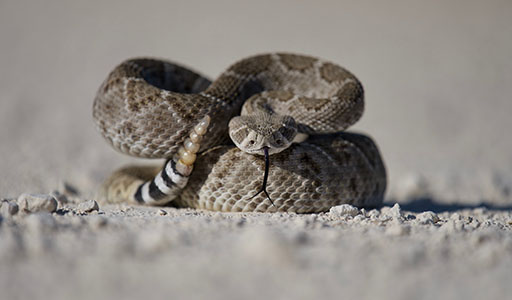Snakes

Snake Information
Snakes are scale-covered reptiles common across all of the United States. There are more than 3,000 unique species of snakes living around the world, inhabiting every continent except Antarctica. Particularly if you live in a rural area, snakes are likely to live in and around your property. Not all snakes are poisonous, though many are. Although snakes feed on pesky rodents that may be lurking in your home, they can prove a real threat to you, your family, and your pets. There are many signs of snakes you can look out for, such as droppings, shed skin, or tracks.

What does a Snake look like?
Ranging in color from dull brown and black to green, snakes maintain an appearance that usually depends on their surroundings. For example, aquatic snakes have flattened bodies, while snakes that live in trees are typically longer and more slender than those that live on the ground. They are highly flexible and may feature patterns along their bodies that aid in camouflage. The shape of a snake’s head can be used to determine whether they’re likely to be dangerous or not, as venomous snakes usually have triangularly shaped heads.

What does a Snake eat?
Larger snakes, like pythons and boas, eat larger meals, such as deer or pigs. Smaller grass snakes mainly subsist on small insects, fish, and frogs. Most of the snakes found in the United States feed on rodents, birds, eggs, lizards, other snakes, and small mammals.

Snake habitats
As exothermic reptiles, snakes need to regulate their body temperature and must live in areas with consistent access to heat. They prefer to inhabit deserts, forested regions, marshes, plains, and residential areas. Snakes make nests in the ground, treetops, swamps, on farms, in abandoned buildings, and in sheds. We most commonly remove snakes from properties in Georgia, Texas, North Carolina, Louisiana, and South Carolina. Contact your local Trutech office today to learn about our snake removal and exclusion services!
Problems With Snake Eggs
Finding snake eggs is a sign of both current and future pest activity. Baby snakes hunt without parental care, so roughly 25 small predators can immediately explore their new habitat right after they hatch. Juvenile snakes prey on the same small animals as adults, so homes with mice or rat issues may soon have snake problems as well.
Types of Snake Diseases
Salmonella is a bacteria found in the digestive systems of all types of reptiles. Items that have come in contact with their infected feces can cause food poisoning when ingested. Stemming from a bacteria common in dirt, botulism is a life-threatening illness that can also be transmitted by snakes. Since the pests spend most of their time at ground level, they are often covered in it. Despite its complicated name, campylobacteriosis is actually one of the most common bacterial infections humans get, causing diarrhea, abdominal pain, and fever. Leptospirosis also leads to flu-like symptoms, in addition to a persistent and severe headache.
Frequently Asked Questions
Since snakes are adaptable to multiple climates and regions, they can be categorized as ground-dwelling or arboreal and as venomous or non-venomous. Arboreal, or tree, snakes are generally more active and smaller than their ground-dwelling counterparts, which are heavy-bodied and sedentary. Due to the irregular feeding patterns and infrequent defecation of both varieties, finding snake droppings is rarely the easiest way to confirm an infestation. Still, homeowners with snake problems may find some waste left by these pests.
Snake droppings are tubular and cord-like, but may have a pinched, irregular surface. They are dark in color with pale, whitish streaks of dried urine. Many people initially mistake snake droppings for bird waste, since they have a similar appearance. The presence of snakes in yards is not likely to produce a large amount of excrement. Not only are droppings small in size, but certain species can retain fecal matter for months. As a result, even well-fed snakes may not leave much waste behind.
Snake eggs have a leathery shell and are usually a white or pale cream color. The pests can lay up to 20 to 30 eggs at a time, and young typically hatch within three months. Compost piles, mulch, and dry or rotting wood are common egg-laying sites.
Since they have no limbs, snakes travel in intriguing ways across sand, soil, and dust. Snake tracks can appear in a number of different forms that depend on the type of snake, its size, and the kind of terrain. Most often, the pests move in a curved, S-like motion, bending their bodies from head to tail and pushing against surrounding surfaces. This type of movement is called lateral undulation, and many species leave these snake tracks in sand or dirt. As the pests live in warm regions or hibernate during cold winters, snake tracks in the snow are seldom seen. Moreover, large or thick species sometimes travel in a direct line and leave straight snake tracks in the dirt.


